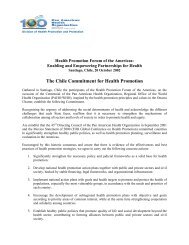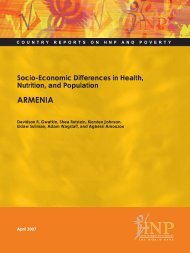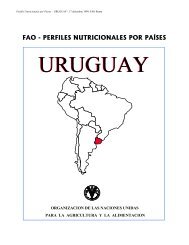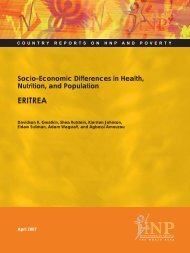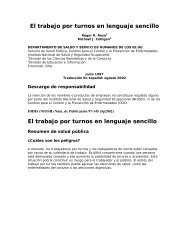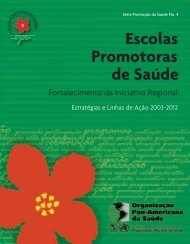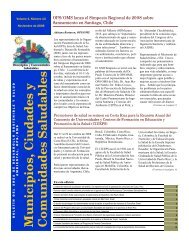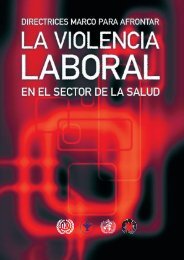Guidelines for drinking-water quality. Volume 1 - BVSDE
Guidelines for drinking-water quality. Volume 1 - BVSDE
Guidelines for drinking-water quality. Volume 1 - BVSDE
You also want an ePaper? Increase the reach of your titles
YUMPU automatically turns print PDFs into web optimized ePapers that Google loves.
c NA, not applicable. Process not designed to remove turbidity and/or bacteria.<br />
Bacteriological <strong>quality</strong><br />
Water intended <strong>for</strong> <strong>drinking</strong> and household purposes must not contain <strong>water</strong>-borne pathogens.<br />
Because the most numerous and the most specific bacterial indicator of faecal pollution from<br />
humans and animals is E. coli, it follows that E. coli or thermotolerant coli<strong>for</strong>m organisms must not<br />
be present in 100-ml samples of any <strong>water</strong> intended <strong>for</strong> <strong>drinking</strong> (see Annex 2, Table A2.1).<br />
This criterion is readily achievable by <strong>water</strong> treatment (see section 6.3). In nearly all epidemics of<br />
<strong>water</strong>borne disease, it has been shown that the bacteriological <strong>quality</strong> of the <strong>water</strong> was<br />
unsatisfactory and that there was evidence of failure in terminal disinfection.<br />
During distribution, the bacteriological <strong>quality</strong> of <strong>water</strong> may deteriorate. Coli<strong>for</strong>m bacteria other<br />
than E. coli can occur in inadequately treated supplies, or those contaminated after leaving the<br />
treatment plant, as a result of growth in sediments and on unsuitable materials in contact with the<br />
<strong>water</strong> (washers, packing, lubricants, plastics and plasticizers, <strong>for</strong> example). They may also gain<br />
entrance from soil or natural <strong>water</strong> through leaky valves and glands, repaired mains, or backsiphonage.<br />
This type of contamination is most likely to be found when the <strong>water</strong> is untreated or<br />
undisinfected, or where there is limited or no residual disinfectant. Allowance can be made <strong>for</strong> the<br />
occasional occurrence in the distribution system of coli<strong>for</strong>m organisms in up to 5% of samples<br />
taken over any 12-month period, provided E. coli is not present (Table A2.1). It must be stressed<br />
that any regular occurrence of coli<strong>for</strong>m organisms is a matter of concern and should be<br />
investigated.<br />
Virological <strong>quality</strong><br />
Drinking-<strong>water</strong> must essentially be free of human enteroviruses to ensure negligible risk of<br />
transmitting viral infection. Any <strong>drinking</strong>-<strong>water</strong> supply subject to faecal contamination presents a<br />
risk of viral disease to consumers. Two approaches can be used to ensure that the risk of viral<br />
infection is kept to a minimum: providing <strong>drinking</strong>-<strong>water</strong> from a source verified free of faecal<br />
contamination, or adequately treating faecally contaminated <strong>water</strong> to reduce enteroviruses to a<br />
negligible level.<br />
Virological studies have shown that <strong>drinking</strong>-<strong>water</strong> treatment can considerably reduce the levels<br />
of viruses but may not eliminate them completely from very large volumes of <strong>water</strong>. Virological,<br />
epidemiological, and risk analyses are providing important in<strong>for</strong>mation, although it is still<br />
insufficient <strong>for</strong> deriving quantitative and direct virological criteria. Such criteria cannot be<br />
recommended <strong>for</strong> routine use because of the cost, complexity, and lengthy nature of virological<br />
analyses, and the fact that they cannot detect the most relevant viruses.<br />
The guideline criteria shown in Table 5 are based upon the likely viral content of source <strong>water</strong>s<br />
and the degree of treatment necessary to ensure that even very large volumes of <strong>drinking</strong>-<strong>water</strong><br />
have a negligible risk of containing viruses.<br />
Ground <strong>water</strong> obtained from a protected source and documented to be free from faecal<br />
contamination from its zone of influence, the well, pumps, and delivery system can be assumed<br />
to be virus-free. However, when such <strong>water</strong> is distributed, it is desirable that it is disinfected, and<br />
that a residual level of disinfectant is maintained in the distribution system to guard against<br />
contamination.<br />
The <strong>water</strong> must meet guideline criteria <strong>for</strong> turbidity and pH (see Table 5), bacteriological <strong>quality</strong><br />
(see Table A2.1), and parasitological <strong>quality</strong> (see below).<br />
Parasitological <strong>quality</strong>




